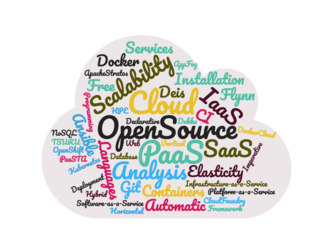
Based on the first part of this analysis, we propose to evaluate in this article the five PaaS solutions that we shortlisted (i.e. OpenShift Origin, Dokku, Deis, PaaSTA, and Flynn). To do this, we will install these solutions on the CETIC infrastructure and we will test their behavior based on two scenarios extracted from two belgian research projects in which we have participated.
In the following, we begin by introducing the test environment of the shortlisted solutions. Then, we present the two scenarios that we will use to evaluate the PaaS solutions. Finally, we define the list of evaluation criteria and we conclude this article with a synthesis.
During this analysis, we will mainly focus on three points that are directly related to the use of PaaS solutions:
Evaluation of the quality of the documentation and the open source community,
Evaluation of the installation process and familiarization with the PaaS solution in terms of time and manpower.
Evaluation of the behavior of a PaaS solution according to the defined scenarios (i.e. the continuous integration, scalability and elasticity).
Date: 18 April 2018
Domaine
Author
During this analysis, we will mainly focus on three points that are directly related to the use of PaaS solutions:
Test environment characteristics
In order to test and evaluate the performance of the five PaaS solutions in a uniform and consistent manner, we propose to use a virtual environment based on the CETIC VMware cluster. Each solution will be installed and tested on a virtual machine equipped with a Ubuntu 16.04 Linux operating system (except for OpenShift which must be installed on CentOS 7), a 16Gb RAM and a 4vCPU processor.
Scenarios of execution
To test the behavior of a given PaaS solution, we propose to use two possible execution scenarios in the cloud environment. These scenarios have been proposed as part of two Belgian research projects and represent real use cases:
PaaS solutions deployment
During the deployment of PaaS solutions on the CETIC infrastructure, we have discarded two solutions. The first one is PaaSTA. Indeed, its installation is too long. It requires the installation of at least seven tools (ie Docker, Mesos, Marathon, Chronos, SmartTask, Sensu and Jenkins). In addition, it is costly in terms of time and it is very resource hungry. Whereas the second solution is Flynn. Its installation relies on the use of an online remote server. This dependency does not meet our requirements in this analysis. In the rest of this blog post, we are interested in the three remaining solutions that are OpenShift Origin, Dokku and Deis.
Analysis criteria
In the following, we present the analysis criteria that we categorize according to the three points presented above:
Synthesis
Based on the table above and our findings made during the installation and testing of PaaS solutions, we present a synthesis for this blog post:
Thanks to this analysis, we make our decision and choose the most suitable PaaS solution for our requirements in the CETIC. Indeed, we select OpenShift Origin since it is one of the most popular open source PaaS solutions used in the industry today. In addition, it is stable and very interoperable because it allows the use of several third-party tools. It ensures automatic deployment and scalability.
References
[1] https://github.com/openshift/origin
[2] https://github.com/dokku/dokku
[3] https://github.com/deis/deis
[4] https://docs.openshift.org/latest/welcome/index.html
[5] http://dokku.viewdocs.io/dokku/getting-started/installation/
[6] https://deis.com/docs/workflow/